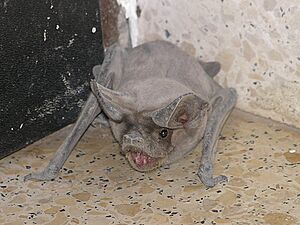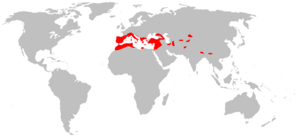European free-tailed bat facts for kids
Quick facts for kids European free-tailed bat |
|
|---|---|
 |
|
| Conservation status | |
| Scientific classification | |
| Genus: |
Tadarida
|
| Species: |
teniotis
|
 |
|
The European free-tailed bat (Tadarida teniotis) is a special type of free-tailed bat. You can find these bats in many parts of the Old World, which includes Europe, Asia, and Africa.
People sometimes call this bat the bulldog bat or mastiff bat. This is because its snout (nose area) has wrinkles, making it look a bit like a dog's face!
These bats live in the Mediterranean parts of Europe. They are also found in different places across Asia. They can live from sea level all the way up to high mountains, about 3,100 meters (10,000 feet) high. Their home range stretches from the Canary Islands to the Middle East. Some bats that look like them in Japan, Taiwan, and Korea are now thought to be a different species called Tadarida insignis.
Contents
About the European Free-Tailed Bat
This bat has big, wide ears. Each ear has a tiny part called a tragus. This small part helps the bat hear sounds better. Its nose area has wrinkled lips, which is why it gets its dog-like nicknames.
The European free-tailed bat has a strong, fleshy tail. The last third of its tail is not connected to any skin membranes. This is different from many other bats.
Its fur is short and smooth. The fur on its back is greyish-black with a brownish shine. The fur on its belly is lighter in color. Its ears, wings, and tail membranes are all black. This bat also has a unique, strong smell.
A grown European free-tailed bat is about 3.5 inches (9 cm) long from head to body. Its tail adds another 2 inches (5 cm). These bats usually weigh between 1 to 2 ounces (28 to 57 grams).
How These Bats Live
During the day, European free-tailed bats rest in hidden spots. They like cracks in cliffs or rocky areas. You might also find them under overhangs or in holes in tall buildings. They can even hide under roof tiles or stone bridges.
When evening comes, they fly out to hunt. They fly very high and in a straight line. Unlike many other bats, they don't make sudden twists and turns. They catch insects while flying. They rarely need to drink water. If they do, they scoop it up from a pond or river while flying low over the surface.
Before leaving their roost, they make a rattling sound. When they are flying, they often make a special "tsick-tsick" noise. This sound helps people recognize them.
Life Cycle and Young Bats
European free-tailed bats often live alone. However, female bats come together in small groups when it's time to have babies.
A female bat carries her baby for about 80 days. She gives birth to one baby bat in a dark, secret place. The baby bat opens its eyes when it is about one week old. It can start flying when it is about four weeks old. By seven weeks, the young bat can live on its own. These bats become adults when they are about one year old. They can live for about ten years.
Status of the European Free-Tailed Bat
The European free-tailed bat is listed as "Least Concern" by the IUCN. This means that experts believe it is not currently in danger of disappearing.
However, these bats do face some challenges. These include the use of chemicals called pesticides. Losing forests and old roosting spots in buildings can also be a problem. Wind turbines might also cause them harm. But overall, these threats are not seen as very serious for the species.
We don't know exactly how their numbers are changing. But they are common in places where they can find good homes. Bats in general are protected in many countries in the European Union.


